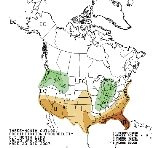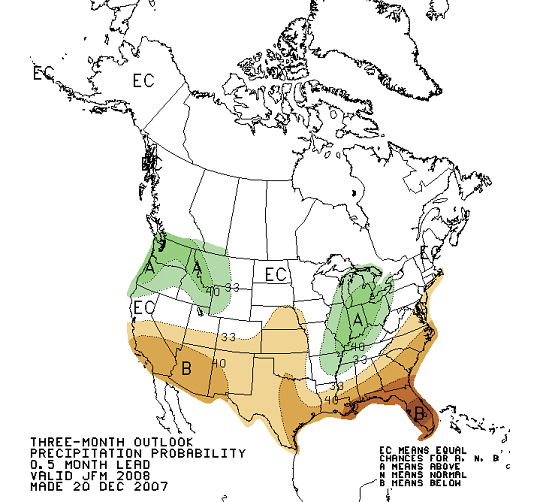
Climate Prediction Center
Encyclopedia
The Climate Prediction Center (CPC) is one of the National Centers for Environmental Prediction
, which are a part of NOAA's National Weather Service
. It is located in Camp Springs, Maryland
.
 The CPC's products are operational predictions of climate variability, real-time monitoring of global climate, and attribution of the origins of major climate anomalies. The products cover time scales from a week to seasons, and cover the land, the ocean, and the atmosphere, extending into the stratosphere
The CPC's products are operational predictions of climate variability, real-time monitoring of global climate, and attribution of the origins of major climate anomalies. The products cover time scales from a week to seasons, and cover the land, the ocean, and the atmosphere, extending into the stratosphere
.
These climate services are available for users in government, the public and private industry, both in this country and abroad. Applications include the mitigation of weather related natural disasters and uses for social and economic good in agriculture
, energy
, transportation, water resources
, and health
. Continual product improvements are supported through diagnostic research, increasing use of models, and interactions with user groups. Some specific products include:
, the third President of the United States
. A century later, the federal government assigned to the Army Signal Corps the mission to define the climate of the regions of the country being opened for farming.
In 1890, the United States Department of Agriculture
(USDA) created the Weather Bureau climate and crops services which began publishing the Weather and Crops Weekly Bulletin, which the CPC in conjunction with the USDA still publishes today.
In 1970, various federal weather and climate functions were consolidated into the National Weather Service (NWS) and placed in a new agency called the National Oceanic and Atmospheric Administration (NOAA). In the 1980s the National Weather Service established the Climate Prediction Center, known at the time as the Climate Analysis Center (CAC). The CPC is best known for its United States climate forecasts based on El Niño and La Niña
conditions in the tropical Pacific.
National Centers for Environmental Prediction
The United States National Centers for Environmental Prediction delivers national and global weather, water, climate and space weather guidance, forecasts, warnings and analyses to its Partners and External User Communities...
, which are a part of NOAA's National Weather Service
National Weather Service
The National Weather Service , once known as the Weather Bureau, is one of the six scientific agencies that make up the National Oceanic and Atmospheric Administration of the United States government...
. It is located in Camp Springs, Maryland
Camp Springs, Maryland
Camp Springs is an unincorporated area and census-designated place in Prince George's County, Maryland, United States. The population was 17,968 at the 2000 census. Camp Springs is not an official post office designation, but rather the area is divided between the surrounding mailing addresses...
.
Products

Stratosphere
The stratosphere is the second major layer of Earth's atmosphere, just above the troposphere, and below the mesosphere. It is stratified in temperature, with warmer layers higher up and cooler layers farther down. This is in contrast to the troposphere near the Earth's surface, which is cooler...
.
These climate services are available for users in government, the public and private industry, both in this country and abroad. Applications include the mitigation of weather related natural disasters and uses for social and economic good in agriculture
Agriculture
Agriculture is the cultivation of animals, plants, fungi and other life forms for food, fiber, and other products used to sustain life. Agriculture was the key implement in the rise of sedentary human civilization, whereby farming of domesticated species created food surpluses that nurtured the...
, energy
Energy
In physics, energy is an indirectly observed quantity. It is often understood as the ability a physical system has to do work on other physical systems...
, transportation, water resources
Water resources
Water resources are sources of water that are useful or potentially useful. Uses of water include agricultural, industrial, household, recreational and environmental activities. Virtually all of these human uses require fresh water....
, and health
Health
Health is the level of functional or metabolic efficiency of a living being. In humans, it is the general condition of a person's mind, body and spirit, usually meaning to be free from illness, injury or pain...
. Continual product improvements are supported through diagnostic research, increasing use of models, and interactions with user groups. Some specific products include:
- 3-Month Temperature and Precipitation
- Outlooks
- Discussions
- 1-Month Temperature and Precipitation
- Outlooks
- Discussions
- 6 to 10-Day and 8 to 14-Day Products
- Temperature and Precipitation Anomaly
- Excessive Heat Outlook
- Maximum Heat Index Prediction
- 3-Month Probability of Exceedance
- Temperature
- Precipitation
- Heating and Cooling Degree Days
- Hurricane Season Outlook
- Atlantic basin
- Pacific basin
- U.S. Drought
- Outlook
- Discussion
- International Support
- Weekly Afghan Hazards
- Weekly Africa Hazards
- Weekly Central America Hazards
- Weekly Haiti Hazards
History
The roots of modern climate prediction can be traced to the late 18th century. One of the nation's first applied climatologists was Thomas JeffersonThomas Jefferson
Thomas Jefferson was the principal author of the United States Declaration of Independence and the Statute of Virginia for Religious Freedom , the third President of the United States and founder of the University of Virginia...
, the third President of the United States
President of the United States
The President of the United States of America is the head of state and head of government of the United States. The president leads the executive branch of the federal government and is the commander-in-chief of the United States Armed Forces....
. A century later, the federal government assigned to the Army Signal Corps the mission to define the climate of the regions of the country being opened for farming.
In 1890, the United States Department of Agriculture
United States Department of Agriculture
The United States Department of Agriculture is the United States federal executive department responsible for developing and executing U.S. federal government policy on farming, agriculture, and food...
(USDA) created the Weather Bureau climate and crops services which began publishing the Weather and Crops Weekly Bulletin, which the CPC in conjunction with the USDA still publishes today.
In 1970, various federal weather and climate functions were consolidated into the National Weather Service (NWS) and placed in a new agency called the National Oceanic and Atmospheric Administration (NOAA). In the 1980s the National Weather Service established the Climate Prediction Center, known at the time as the Climate Analysis Center (CAC). The CPC is best known for its United States climate forecasts based on El Niño and La Niña
La Niña
La Niña is a coupled ocean-atmosphere phenomenon that is the counterpart of El Niño as part of the broader El Niño-Southern Oscillation climate pattern. During a period of La Niña, the sea surface temperature across the equatorial Eastern Central Pacific Ocean will be lower than normal by 3–5 °C...
conditions in the tropical Pacific.
External links
- http://www.cpc.noaa.gov/index.php

